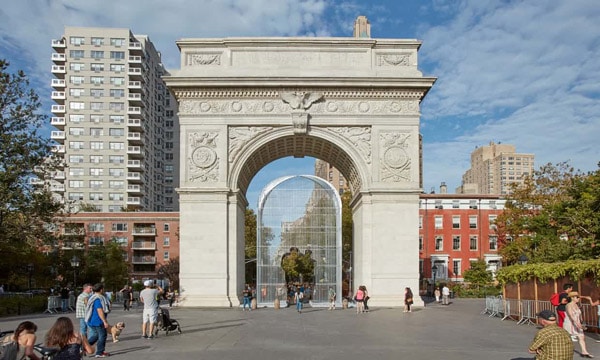Ai Weiwei Launches Controversial Public Art Project Focused on Immigration
Nadja Sayej, The Guardian, October 11, 2017
In 1937, French artist André Breton opened a surrealist art gallery in Paris called Gradiva. The artist Marcel Duchamp designed the glass door entranceway with a silhouette of two figures stepping in unison, symbolizing cultural advancement, which guests could walk through.
That very same silhouette is making a comeback, rebuilt in steel under the arch of the Washington Square Park monument in New York City. It’s part of Good Fences Make Good Neighbors, a public art exhibition by Chinese artist Ai Weiwei which has launched this week and continues to 11 February.
The artist who has covered a concert house in refugee life jackets recently made a documentary on the refugee crisis called Human Flow which received its premiere at this year’s Venice film festival. “The purpose is to show it to people of influence; people who are in a position to help and who have a responsibility to help,” he said to the Guardian. “The refugees who need help — they don’t need to see the film. They need dry shoes. They need soup.”
His latest large-scale public artwork, part of 300 installations around the city, is a comment on the political divisiveness and the rise of anti-immigrant nationalism. Anyone can walk through the entranceway of the silhouette, which is meant to represent borderless — and fenceless — territories.
“When I lived in New York in the 1980s, I spent much of my time in Washington Square Park,” said Ai in a statement. “This area was one of New York’s most vibrant and diverse neighborhoods, a home to immigrants of all backgrounds.”
The arch was built in 1892 to celebrate the centennial of George Washington’s presidential inauguration. Ai sees the arch as a symbol of victory after war, but the gateway below “cuts through this barrier, he said, “through which another door opens”.

There are also steel banners of refugees hanging above the Essex Street Market and portraits of New York immigrants on bus shelters in Harlem, Brooklyn and the Bronx. There is also a sculpture at Cooper Union and 48 7th Street, where Ai used to live in a basement apartment from 1983 to 1993.
There is also a circular fence in Central Park, which is painted gold for its proximity to Trump Tower. “I know our president likes gold, so this is really for his appreciation,” explained Ai on Democracy Now last night.
He added: “Any kind of wall is ridiculous, even with the Great Wall of China, it never really worked,” said Ai. “It shows a kind of narrow-minded ideas to divide people and create some kind of hatred between people.”
But some locals aren’t pleased, like the Washington Square Association, who posted a public letter to the Public Art Fund, the exhibition’s backer, which said: “The monumental Arch is a work of art in itself. It does not need to be politicized with the proposed installation.”
Trevor Sumner, the president of the Washington Square Association, said the biggest problem is obstructing the square’s 94-year-old tree lighting tradition, which has drawn thousands every year for Christmas Eve carolling.
“The Public Art Fund did not want to change dates, details, anything at all,” said Sumner. “That was their plan from the get go: to eliminate any and all discussion. It’s hard to say that they know what it means to be good neighbors.”
While the non-profit art organization offered to pay for a low-budget solution — relocating the tree to the park’s open area near the fountain, Sumner says it will put large concrete slabs and dangerous wires around the park. “We are looking at a solution to prop it above the fountain, but this might come at extra cost which I am sure the Public Art Fund will try to avoid,” he said.
“To be clear, we are not fighting against the art installation, but our right to continue our 94-year-old tradition of hosting a tree-lighting in the park.”
The 40ft-tall cage inside the arch is meant to use fences to break down barriers, not add more of them. “Ai Weiwei is highly regarded, his views are respected,” said Woolums. “Weiwei is fine, just not under our busy arch.”
At a press conference in Central Park, Ai explained why he chose fences as symbolic in today’s political turmoil. “Fences or territories always relate to us and our attitude towards others,” he said, as construction work rumbled nearby. “In the US, there are policies to limit refugees and trying to push away people who made a great contribution to society, trying to build a wall between US and Mexico, which is an unthinkable policy.”
“There is no tolerance, it’s divided and trying to separate us by color, race, religion and nationality,” he added. “It’s going backwards against freedom, humanity and our understanding of our time.”
Nicholas Baume, director of the Public Art Fund, has been waiting eight years to work with Ai on an exhibition. They raised $98,000 on Kickstarter for the project.
Baume said he is grateful for the locals being good neighbors. “We really appreciate the residents’ flexibility, it’s a sacrifice to give up,” he said. “Since we’re experienced in putting complicated sculptures around the city, we’ll be able to manage relocating a Christmas tree.”
The artwork has an important message to Baume, who sees the work through the eyes of the artist. “When Ai lived in China, he was an outspoken critic of the regime and a human rights advocate, which led to his imprisonment, abduction and beatings,” he said.
“It wasn’t about putting a sculpture on a pedestal but making something for New York City and woven into the fabric of the city.”















